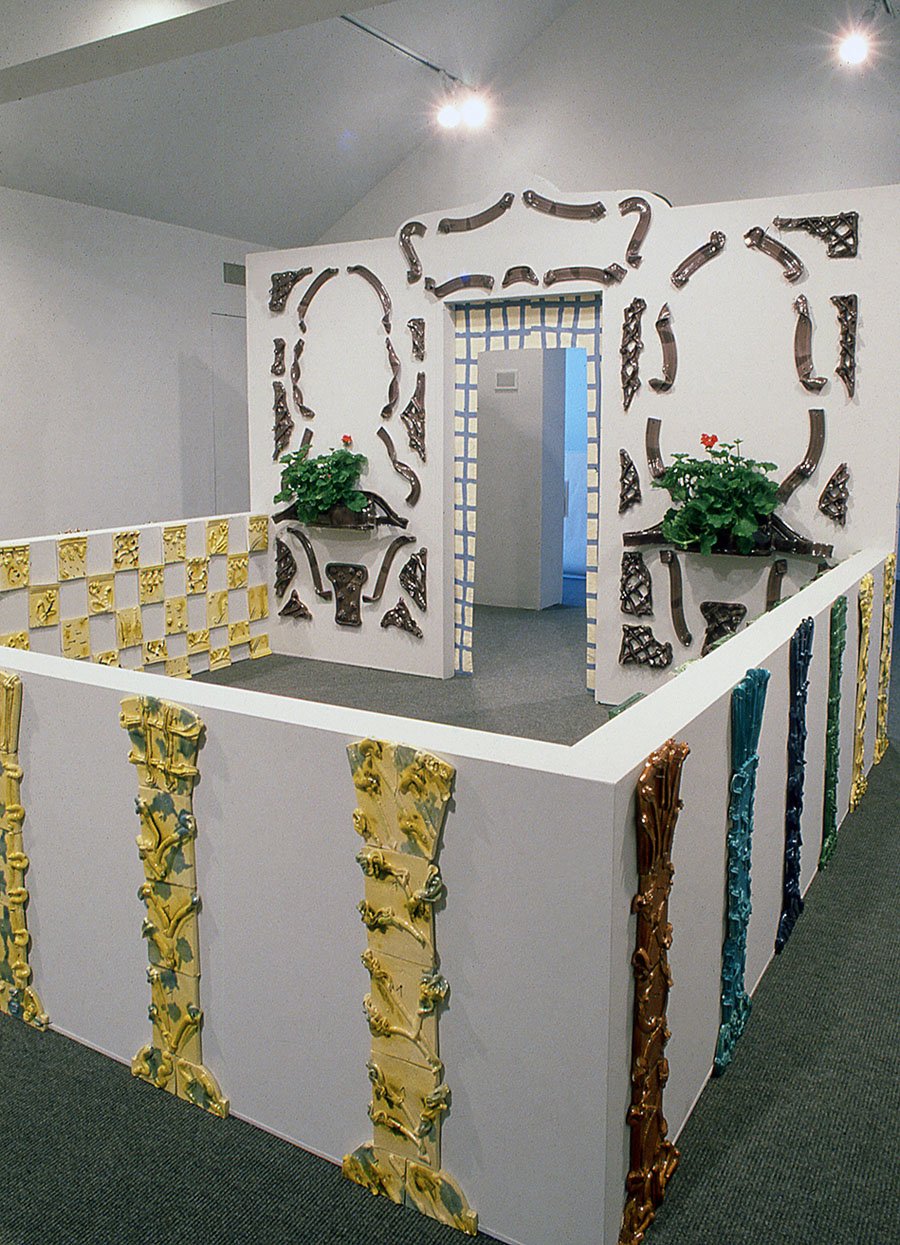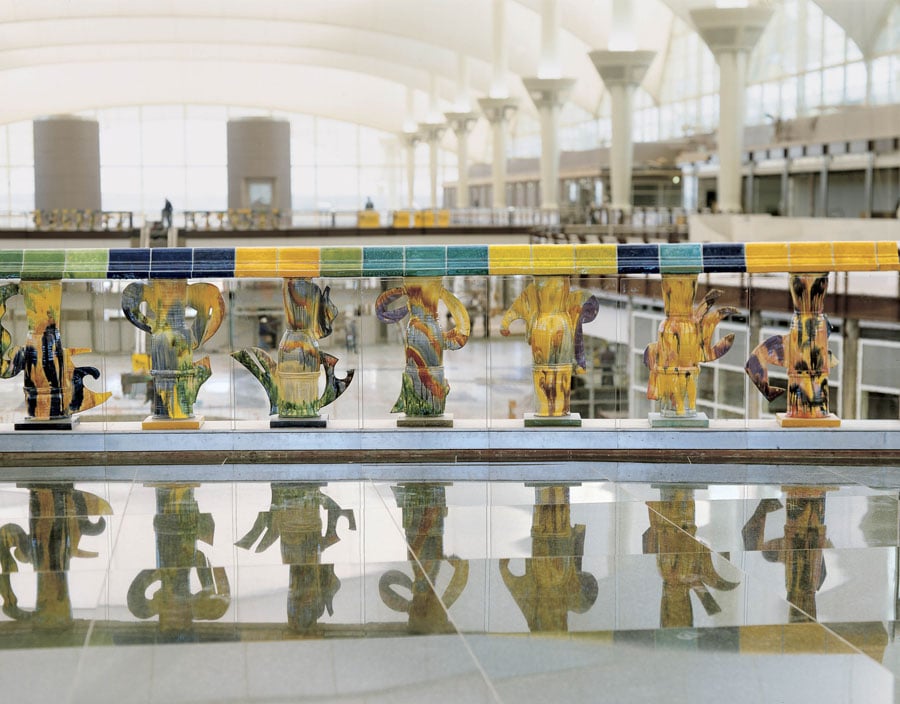
March 16, 2021
Ceramics and Architecture: The Legacy of Betty Woodman
A 1984 Metropolis article captures artists Betty and George Woodman’s nomadic lives. Nearly four decades later, The Woodman Family Foundation archives the architectural sources of Betty’s work.

In October 1984, Metropolis published a story titled Pattern and Place tracing the studio developments of American artist couple Betty and George Woodman during a career-defining transition from New York to Colorado. At the time, Betty had established a name in ceramics through her utilitarian vessels, reliefs, and installations. Her husband, a painter, was known for geometric abstraction. The Woodman Family Foundation’s recently released blog series, Plotlines, emphasizes under-explored aspects of the Woodmans’ work, and for Betty, it is her relationship to architecture.
While trained as a production potter at the School for American Craftsman at Alfred University, Betty became known for pushing the boundaries of functionality toward sculptural abstraction and embodying a painterly perspective in her handling of glazed earthenware. “And she definitely wasn’t a type to look back,” Lissa McClure, director of the Woodman Family Foundation tells Metropolis today.

Penned by Gini Sikes, the 1984 article illustrates the artists as nomadic creatives who float between their New York, Florence, and Boulder homes. Over four ensuing decades, the couple’s commitment to a cross-Atlantic lifestyle had remained intact until George’s passing in 2017, followed nine months later by Betty. The couple often brought architectural reminders from their Tuscan farmhouse into their Chelsea home such as the ceramic wall tiles that can be observed in their kitchen. Soon, a section of their New York studio will operate as a study center on the Woodmans, whether the research subject is Betty’s subversive abstraction or her late daughter, Francesca Woodman’s, performative self-portrait photography and its relation to place.
In the 1980s, Woodman completed an organic transition from functional pottery to transgressive interpretations of the built environment in ceramic. McClure describes it as “turning pottery on its head.” She notes her use of negative space in expansive installations, such as Cloistered Arbor Room at Bennington College’s Usdan Gallery. There, she surrounded what appear as four conventional-looking flower pot vessels with a line of flat ceramic “columns” fixed to the gallery’s walls.

In the Foundation’s blog entry “Alluding to Architecture,” Woodman is quoted in a 2016 interview with frieze: “It’s about the illusion of scale. It’s not really architecture: it’s alluding to that, it’s about that, but it’s smaller than reality.” While other installations such as The Aspen Garden Room at Aspen Art Museum (1984) or Somewhere Between Naples and Denver at ICA Philadelphia (1992) soared well above her small physique, scale never intimidated the artist.
These large-scale wall reliefs and installations would eventually lead her to become the first living woman artist to have a retrospective at New York’s Metropolitan Museum of Art in 2006. “She was less presumptuous than announcing that she was shifting to be an artist—she was just very pragmatic,” says McClure. “Throughout the arc of her career, she used functional shapes as the basis to make wild sculptural engagements.”

In more recent installations such as Theater of the Domestic at Museo Marino Marini in Florence and ICA in London in 2016, Woodman took inspiration from trompe-l’oeil wall paintings of ancient homes in Rome. The shows included various works from later in her career, inspired by her time in Italy as well as the formal qualities of Modernists such as Matisse and Picasso. Fra Angelico’s Room (2012), for example, built an architectural vignette with a canvas painted to illustrate a window view, alongside modest size ceramic sculptures that add a domestic finish to the juxtaposition. Curator Vincenzo de Bellis says, “The misreading of Betty’s work at the beginning of her career was due to the art world’s compartmentalization of objects under either art or artifact.”
While architectural decisions were critical, de Bellis adds, the title Theater of the Domestic was “Betty’s way of reiterating some of the critique about the work being domestic but also this very undermining of domestic labor itself.” The institutional and commercial blossoming of Woodman’s career coincided with the surge in feminist revisionism as museums and galleries escalated efforts to connect the missing dots in the canon of art history. While women never ceased creating, finally, their works began reaching broader audiences, Betty Woodman’s included.
The Woodman Family Foundation was founded by Betty and George to preserve the artwork, archives, and legacies of each of the family members. Upon their deaths, their son Charles Woodman, who is a video artist, became the board’s chair and moved the foundation to his parents’ New York studio on 17th Street.
You may also enjoy “An Exhibition Celebrates 50 Years of the Japan Society and Centuries of Craftsmanship”
Would you like to comment on this article? Send your thoughts to: [email protected]
Register here for Metropolis’s Think Tank Thursdays and hear what leading firms across North America are thinking and working on today.










